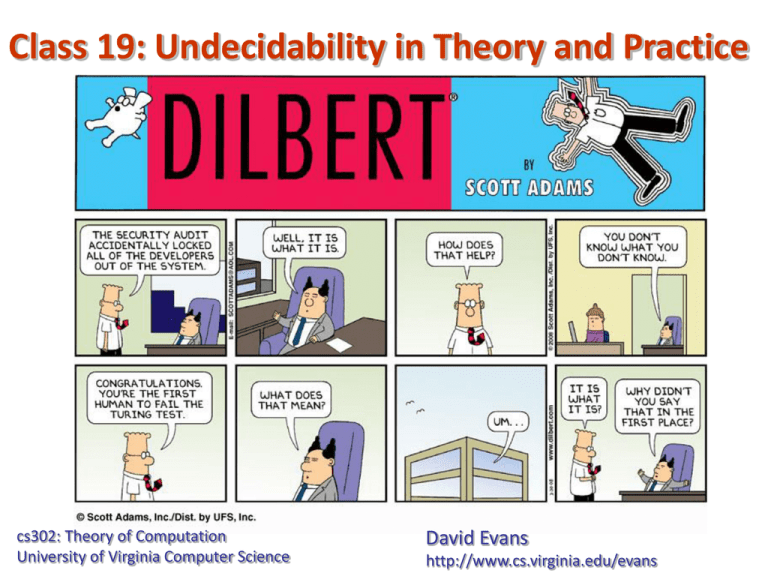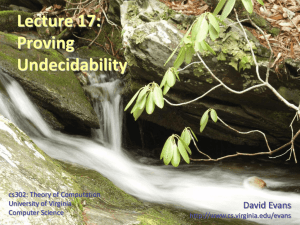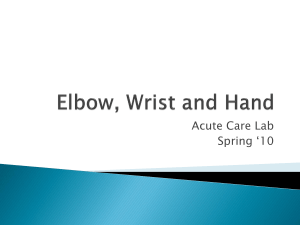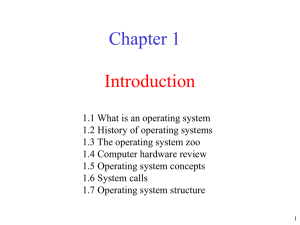PPT - University of Virginia
advertisement

Class 19: Undecidability in Theory and Practice
cs302: Theory of Computation
University of Virginia Computer Science
David Evans
http://www.cs.virginia.edu/evans
Menu
• PS5, Problem 5
• Erudite Discussion on Undecidability
• Busy Beaver Problem
Lecture 19: Undecidability in Theory and Practice
2
PS5, Problem 5
Consider a one-tape Turing Machine that is identical to
a regular Turing machine except the input may not be
overwritten. That is, the symbol in any square that is
non-blank in the initial configuration must never
change. Otherwise, the machine may read and write to
the rest of the tape with no constraints (beyond those
that apply to a regular Turing Machine).
a. What is the set of languages that can be recognized
by an unmodifiable-input TM?
b. Is HALTUTM decidable?
Lecture 19: Undecidability in Theory and Practice
3
Impossibility of Copying
0 1 0 0 1 1 1 0 0 0
input (unmodifiable)
How can the TM keep track of which input square to copy next?
Option 1: Use the writable part of the tape.
Problem: can’t read it without losing head position
Option 2: Use the FSM states.
Problem: there is a finite number of them!
Hence, it is equivalent to a DFA regular languages
Lecture 19: Undecidability in Theory and Practice
4
Nevertheless, HALTUTM is Undecidable
Prove by reducing HALTTM to HALTUTM:
HALTTM(<M, w>) = HALTUTM(<MUw, ε>) where
MUw = an unmodifiable-TM that ignores the input,
writes a # on the tape, followed by w,
then, simulates M on the tape starting at
the first square after the #, treating the
# as if it is the left edge of the tape.
Lecture 19: Undecidability in Theory and Practice
5
Computability in
Theory and Practice
(Intellectual Computability
Discussion on TV Video)
Lecture 19: Undecidability in Theory and Practice
6
Ali G Problem
• Input: a list of numbers (mostly 9s)
• Output: the product of the numbers
LALIG = { < k0, k1, …, kn, p> | each ki
represents a number and p represents a
number that is the product of all the kis.
numbers
Is LALIG decidable?
Yes. It is easy to see a simple
algorithm (e.g., elementary school
multiplication) that solves it.
Can real computers solve it?
Lecture 19: Undecidability in Theory and Practice
7
Ali G was Right!
• Theory assumes ideal computers:
– Unlimited, perfect memory
– Unlimited (finite) time
• Real computers have:
– Limited memory, time, power outages, flaky
programming languages, etc.
– There are many decidable problems we cannot solve
with real computer: the actual inputs do matter (in
practice, but not in theory!)
Lecture 19: Undecidability in Theory and Practice
10
Busy Beavers
Lecture 19: Undecidability in Theory and Practice
11
The “Busy Beaver” Game
• Design a Turing Machine that:
–
–
–
–
Uses k symbols (e.g., “0” and “1”)
Starts with a tape of all “0”s
Eventually halts (can’t run forever)
Has n states (not counting qAccept
and qReject)
• Goal is to run for as many steps
as possible (before halting)
• 2-way infinite tape TM
Tibor Radó, 1962
Lecture 19: Undecidability in Theory and Practice
12
Busy Beaver: N = 1
0
0
0
0
0
0
0
0
0
0
0
0
0
0
0
0
0
0
...
01
Start
qAccept
BB(1, 2) = 1
Most steps a 1-state
machine that halts can make
Lecture 19: Undecidability in Theory and Practice
13
...
0
0
0
0
0
0
0
0
0
0
0
0
0
Input: 0
Write: 1
Move:
Start
A
Input: 0
Write: 1
Move:
B
Input: 1
Write: 1
Move: /
H
Input: 1
Write: 1
Move:
BB(2, 2) = ?
Lecture 19: Undecidability in Theory and Practice
14
0
0
0
...
...
0
0
0
0
0
0
1
0
0
0
0
0
0
0
0
0
...
Input: 0
Write: 1
Move:
Start
A
Input: 0
Write: 1
Move:
B
Input: 1
Write: 1
Move: /
H
Input: 1
Write: 1
Move:
Step 2
Lecture 19: Undecidability in Theory and Practice
15
...
0
0
0
0
0
0
1
1
0
0
0
0
0
0
0
0
...
Input: 0
Write: 1
Move:
Start
A
Input: 0
Write: 1
Move:
B
Input: 1
Write: 1
Move: /
H
Input: 1
Write: 1
Move:
Step 3
Lecture 19: Undecidability in Theory and Practice
16
...
0
0
0
0
0
0
1
1
0
0
0
0
0
0
0
0
...
Input: 0
Write: 1
Move:
Start
A
Input: 0
Write: 1
Move:
B
Input: 1
Write: 1
Move: /
H
Input: 1
Write: 1
Move:
Step 4
Lecture 19: Undecidability in Theory and Practice
17
...
0
0
0
0
0
1
1
1
0
0
0
0
0
0
0
0
...
Input: 0
Write: 1
Move:
Start
A
Input: 0
Write: 1
Move:
B
Input: 1
Write: 1
Move: /
H
Input: 1
Write: 1
Move:
Step 5
Lecture 19: Undecidability in Theory and Practice
18
...
0
0
0
0
1
1
1
1
0
0
0
0
0
0
0
0
...
Input: 0
Write: 1
Move:
Start
A
Input: 0
Write: 1
Move:
B
Input: 1
Write: 1
Move: /
H
Input: 1
Write: 1
Move:
Step 6
Lecture 19: Undecidability in Theory and Practice
19
...
0
0
0
0
1
1
1
1
0
0
0
0
0
0
0
0
...
Input: 0
Write: 1
Move:
Start
A
Input: 0
Write: 1
Move:
B
Input: 1
Write: 1
Move: /
H
Input: 1
Write: 1
Move:
BB(2, 2) 6
(Actually, known that BB(2,2) = 6)
Lecture 19: Undecidability in Theory and Practice
20
Halted
What is BB(6, 2)?
Lecture 19: Undecidability in Theory and Practice
21
0/0/R
B
0/1/R
Start
A
C
1/1/R
0/1/L
1/0/L 1/0/R
1/0/L
F
D 0/0/L
E
0/1/L
1/1/H
1/1/R
0/0/R
H
6-state machine found by Buntrock and Marxen, 2001
Lecture 19: Undecidability in Theory and Practice
22
0/0/R
C
B
0/1/R
Start
A
0/1/L
1/0/L
1/0/L
F
1/0/R
E
D
1/1/R
0/1/L
1/1/H
1/1/R
0/0/L
0/0/R
H
(1730 digits)
Best found
before 2001,
only 925 digits!
30023277165235628289551030183413401851477543372467525003
73381801735214240760383265881912082978202876698984017860
71345848280422383492822716051848585583668153797251438618
56173020941548768557007853865875730485748722204003076984
40450988713670876150791383110343531646410779192098908371
64477363289374225531955126023251172259034570155087303683
65463087415599082251612993842583069137860727367070819016
05255340770400392265930739979231701547753586298504217125
13378527086223112680677973751790032937578520017666792246
83990885592036293376774476087012844688345547780631649160
18557844268607690279445427980061526931674528213366899174
60886106486574189015401194034857577718253065541632656334
31424232559248670011850671658130342327174896542616040979
71730737166888272814359046394456059281752540483211093060
02474658968108793381912381812336227992839930833085933478
85317657470277606285828915656839229596358626365413938385
67647280513949655544096884565781227432963199608083680945
36421039149584946758006509160985701328997026301708760235
50023959811941059214262166961455282724442921741646549436
38916971139653168926606117092900485806775661787157523545
94049016719278069832866522332923541370293059667996001319
37669855168384885147462515209456711061545198683989449088
56870822449787745514532043585886615939797639351028965232
95803940023673203101744986550732496850436999753711343067
32867615814626929272337566201561282692410545484965841096
15740312114406110889753498991567148886819523660180862466
87712098553077054825367434062671756760070388922117434932
63344477313878371402373589871279027828837719826038006510
50757929252394534506229992082975795848934488862781276290
44163292251815410053522246084552761513383934623129083266
949377380950466643121689746511996847681275076313206
http://drb9.drb.insel.de/~heiner/BB/index.html
Lecture 19: Undecidability in Theory and Practice
23
Busy Beaver Numbers
•
•
•
•
•
BB(1) = 1
BB(2) = 6
BB(3) = 21
BB(4) = 107
BB(5) = Unknown!
– The best found so far is 47,176,870
• BB(6) > 102879
Lecture 19: Undecidability in Theory and Practice
24
Is there a language problem?
LBB= { <n, k, s> | where n and k
represent integers and
s is the maximum
number of steps a TM
with n non-final states
and k tape symbols can
run before halting }
Lecture 19: Undecidability in Theory and Practice
25
Is LBB Decidable?
Lecture 19: Undecidability in Theory and Practice
26
LBB is Undecidable
Proof by reduction:
Assume MBB exists that decides LBB
HALTTM(<M, w>) =
n = number of states in M
k = number of symbols in M’s tape alphabet
find s by trying s = 1, 2, ... until MBB accepts <n, k, s>
simulate M on w for up to s steps
if it halts, accept
if it doesn’t complete, reject
Lecture 19: Undecidability in Theory and Practice
27
Challenges
• The standard Busy Beaver problem is defined
for a doubly-infinite tape TM. For the oneway infinite tape TM, what is BB(4, 2)?
• Find a new record BB number
– http://drb9.drb.insel.de/~heiner/BB/index.html
Exam 2: one week from today.
Lecture 19: Undecidability in Theory and Practice
28









